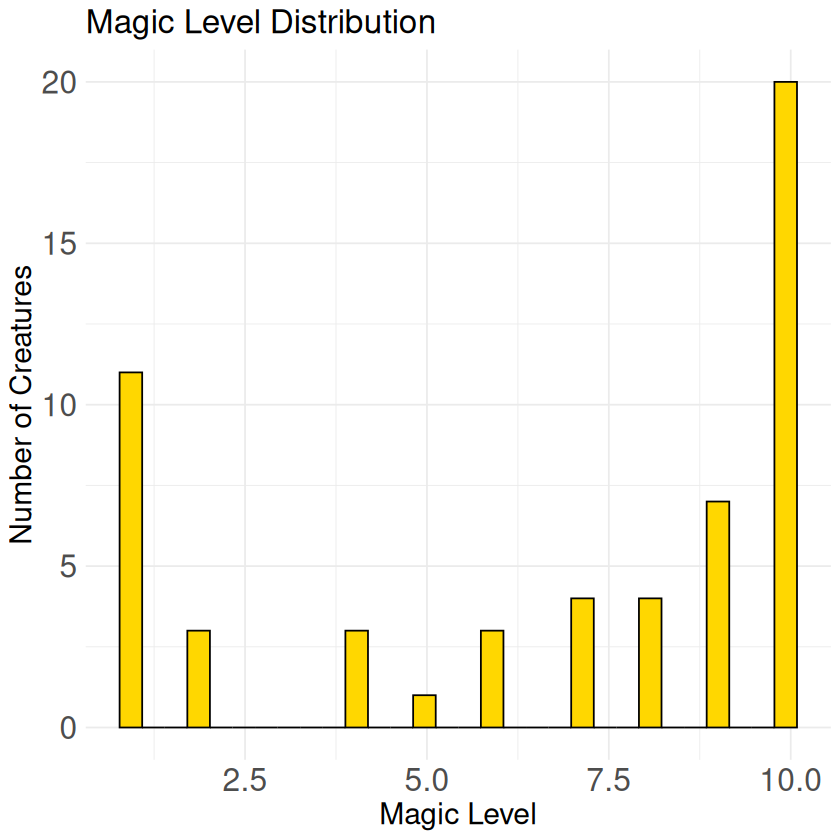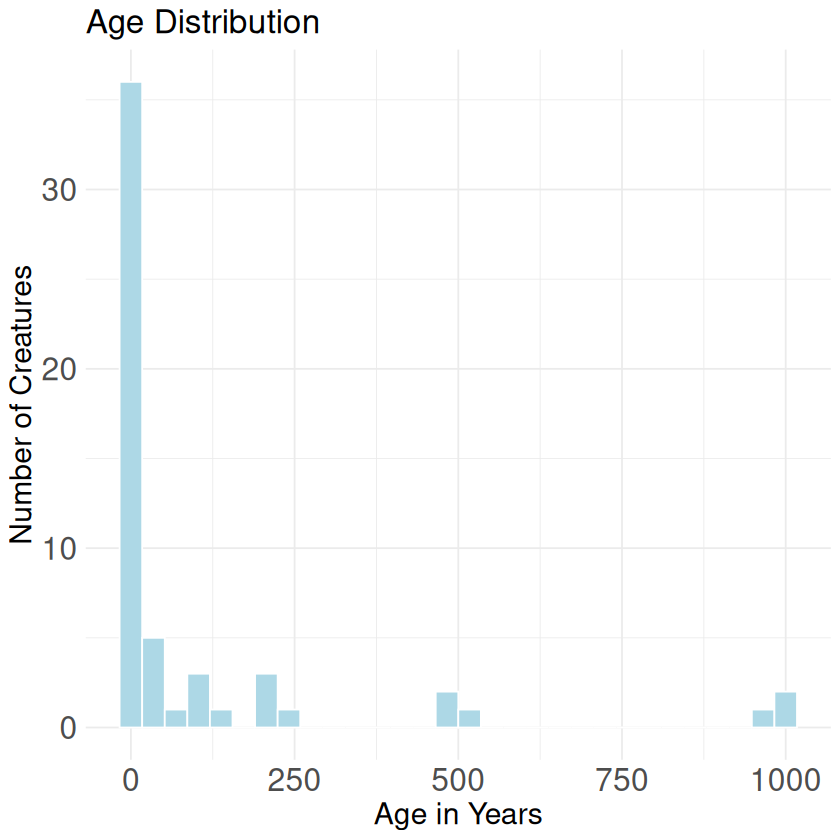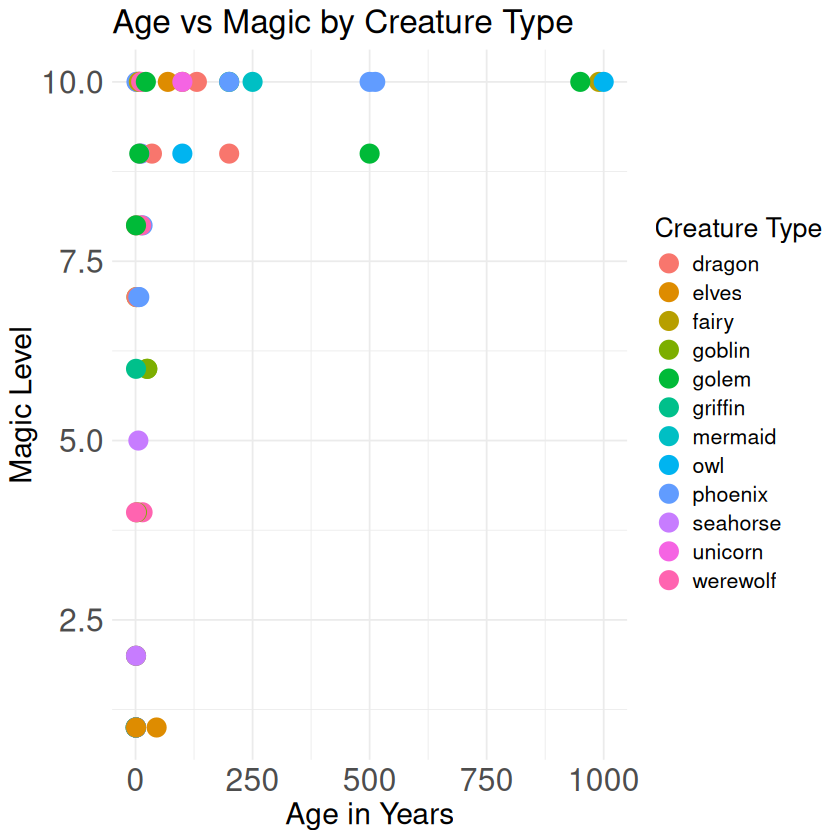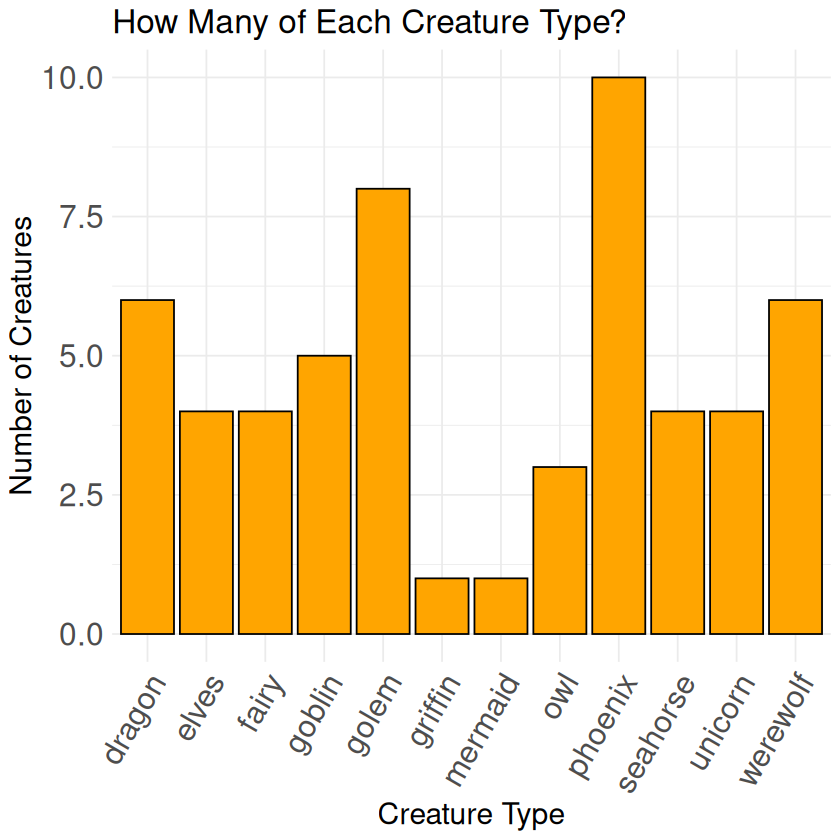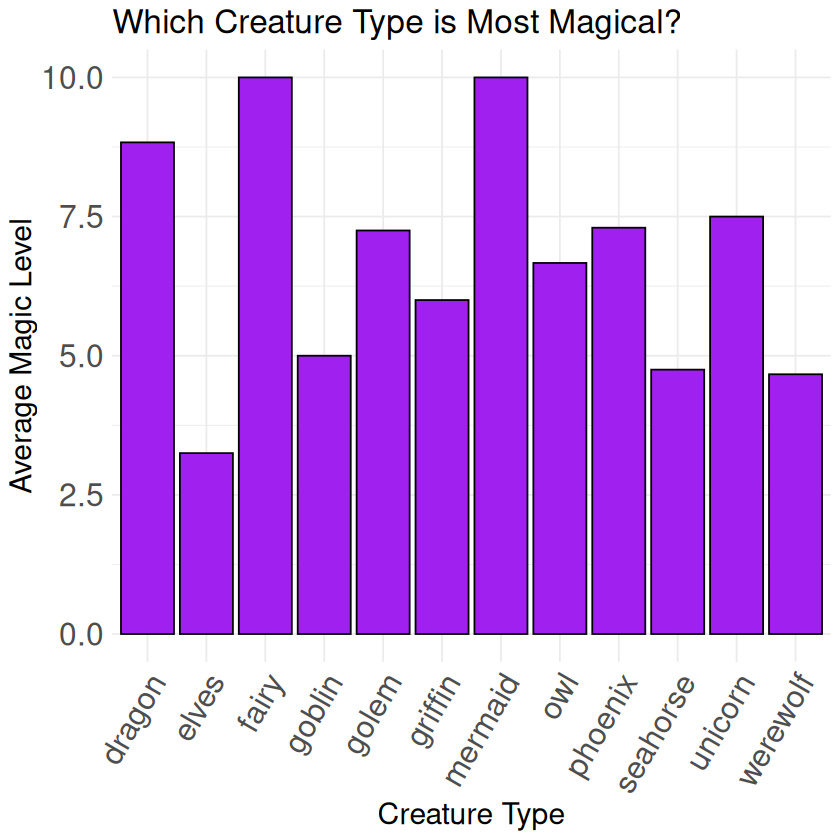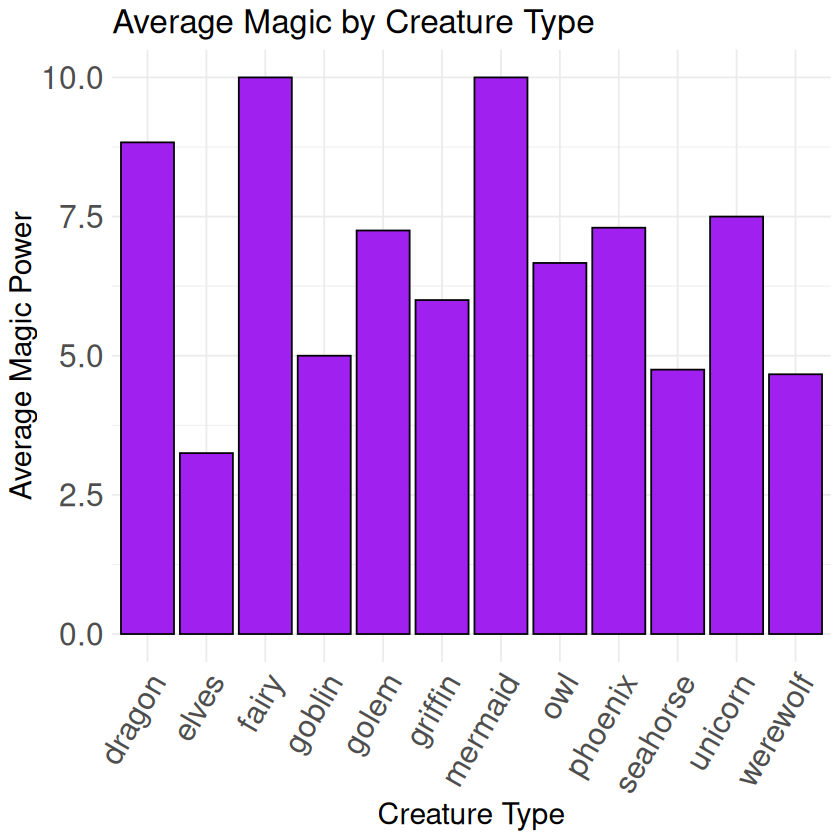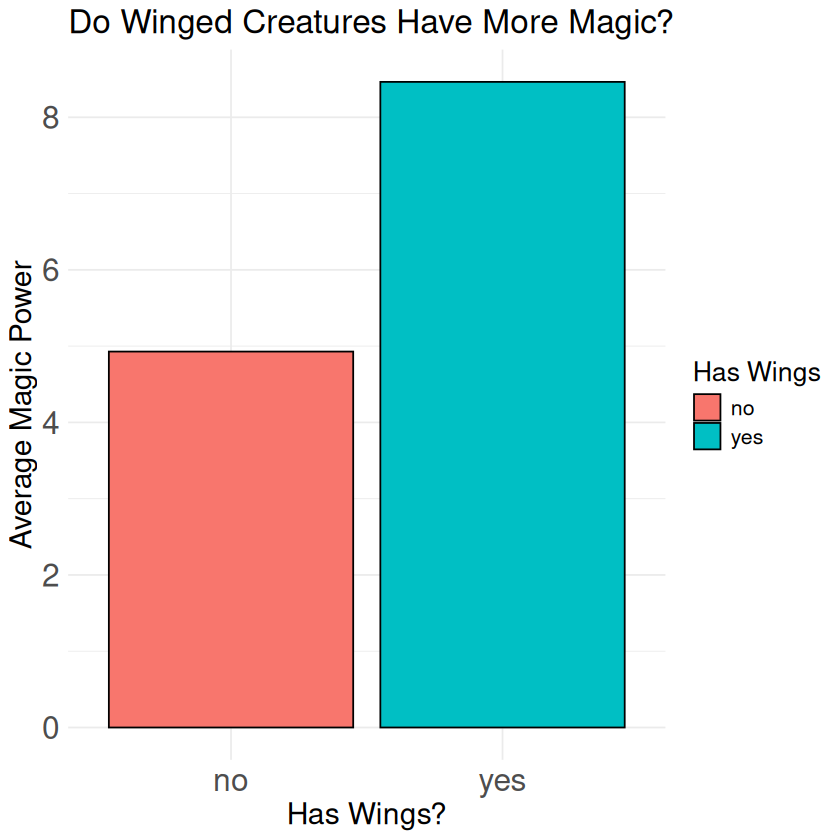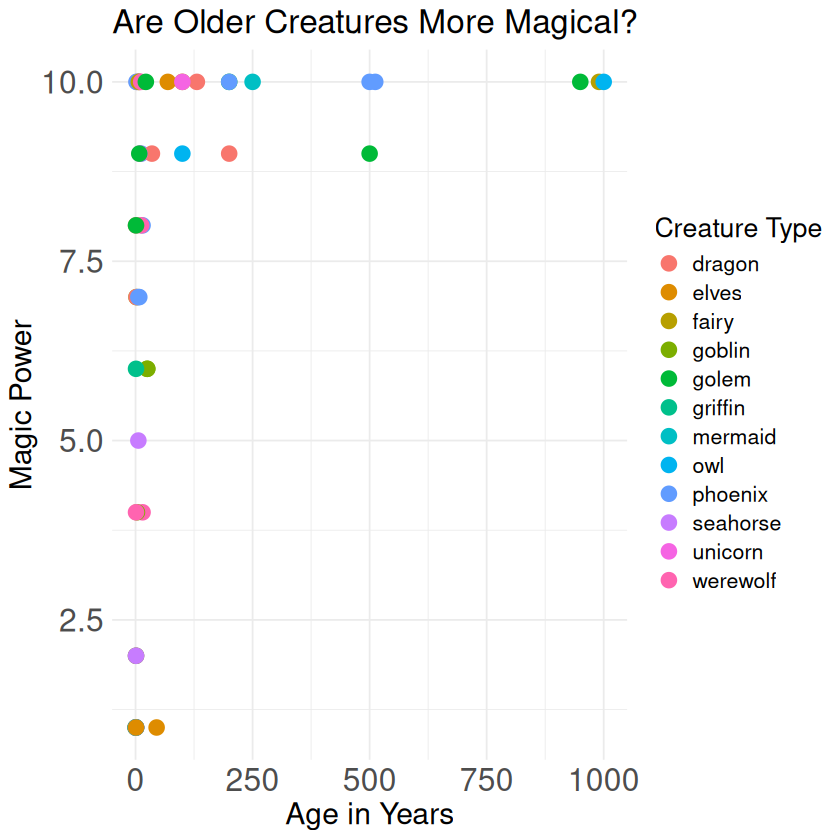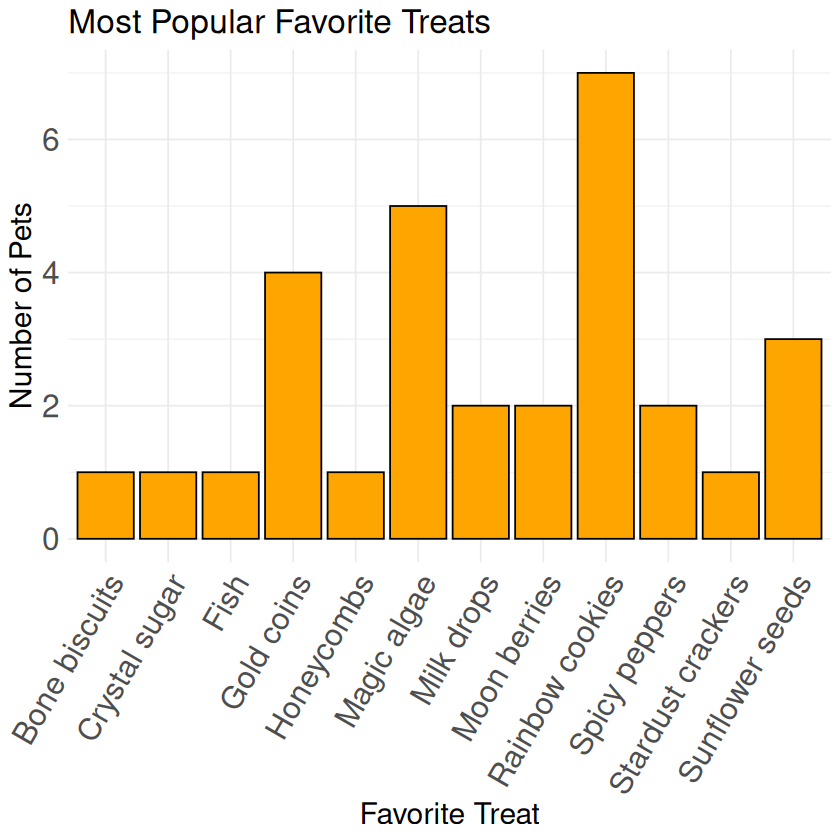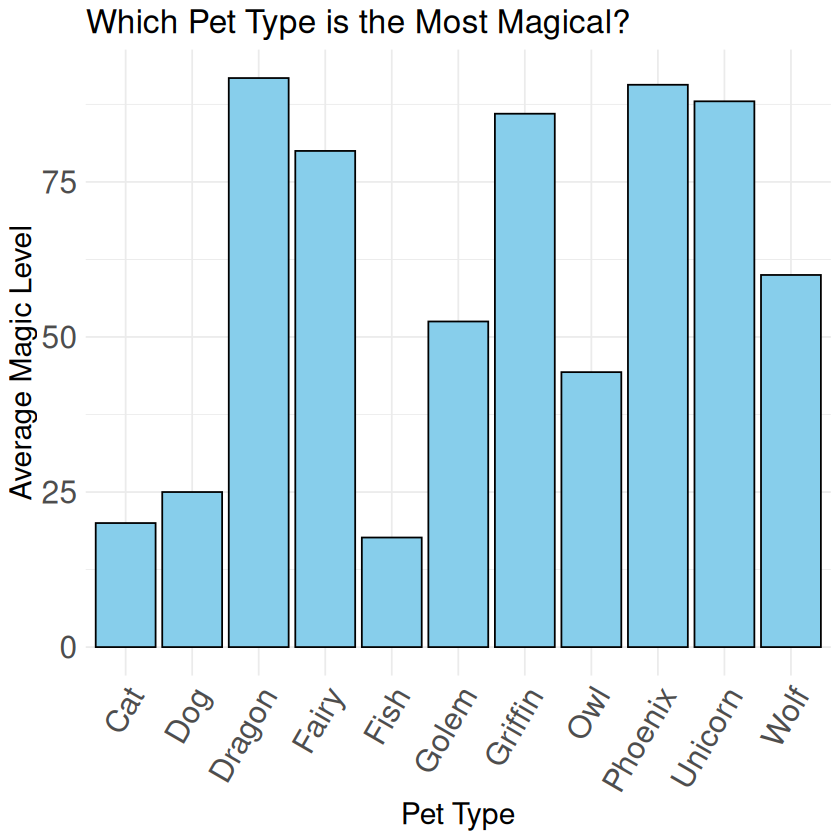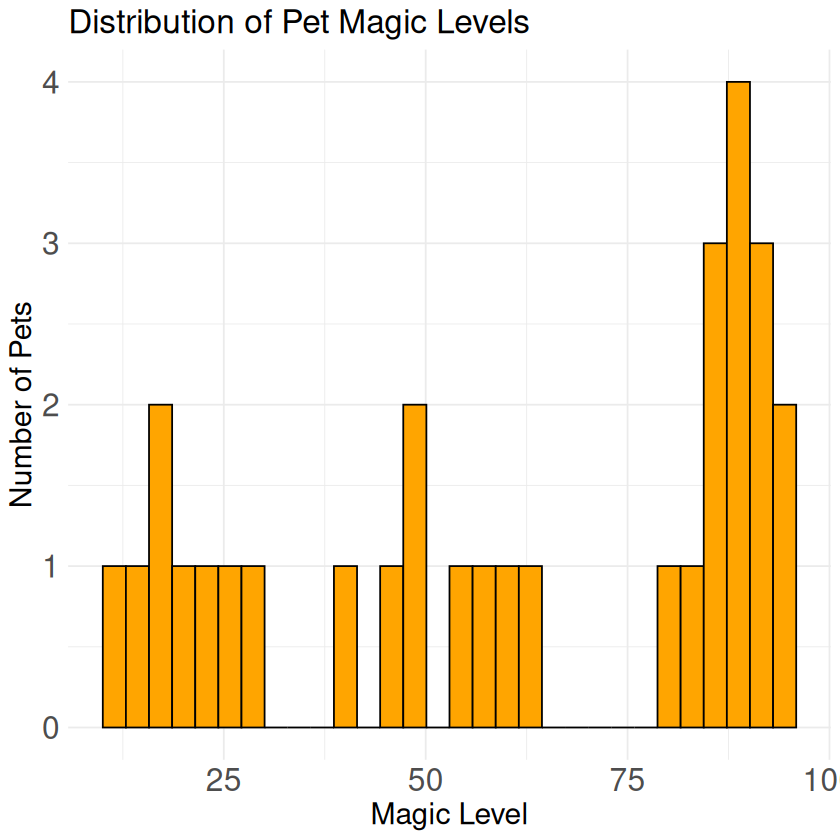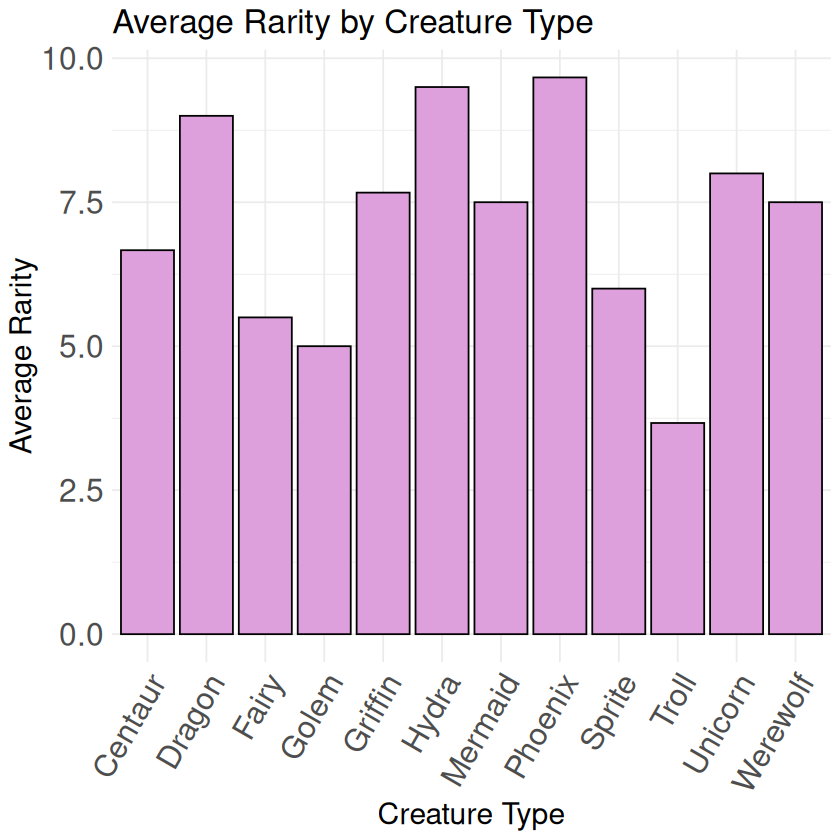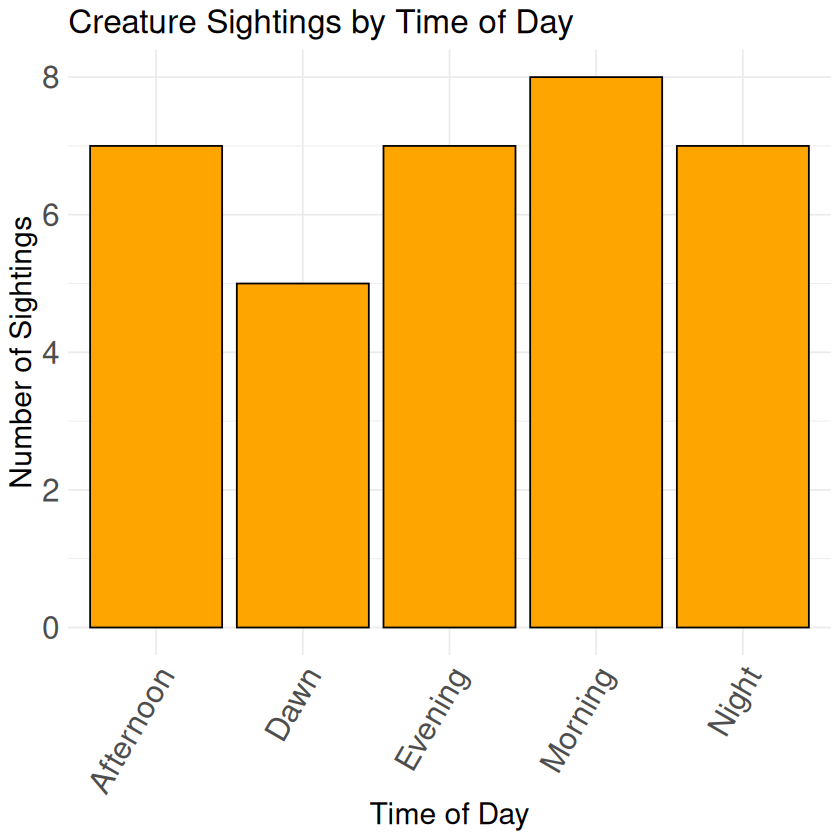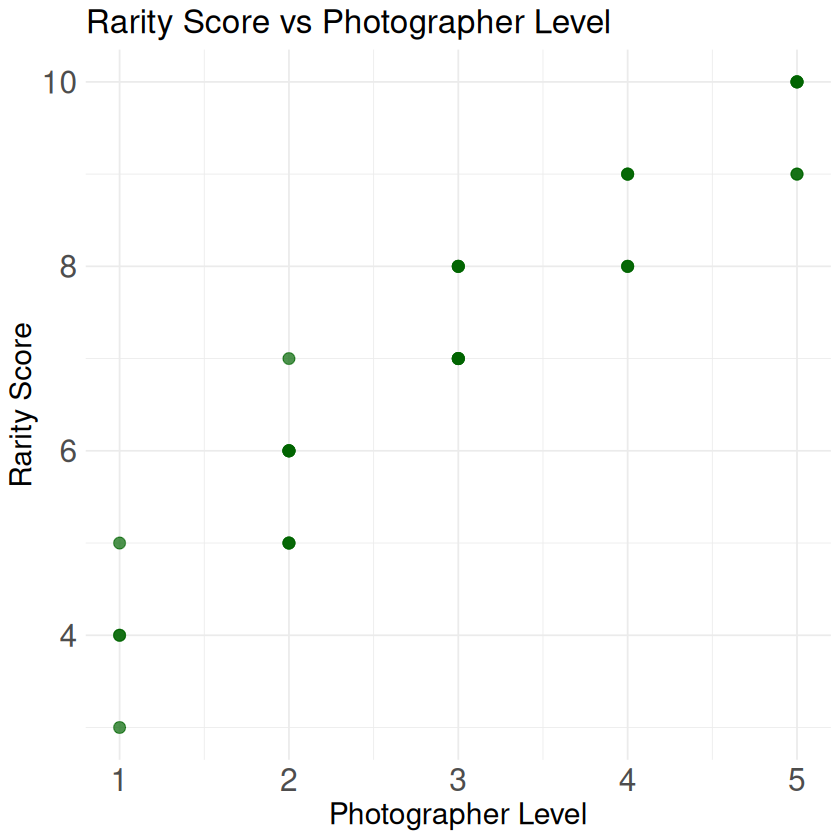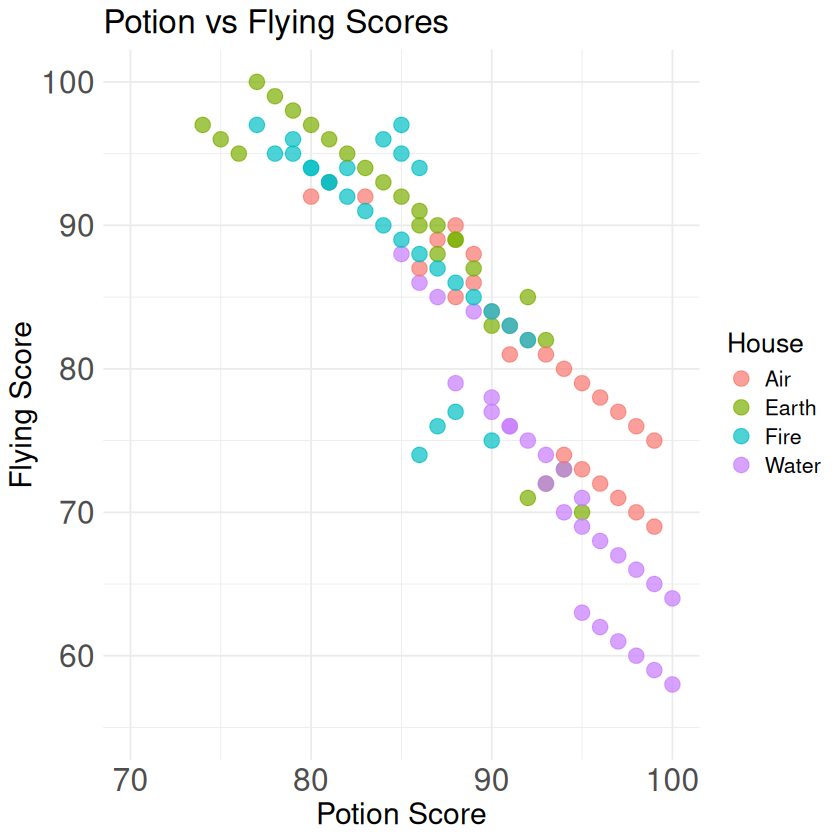🔮 Day 3 - Spell Solutions#
This file contains solutions to all Day 3 spells and their practice challenges
Spell 1: Loading Data Magic#
This spell teaches basic data loading and exploration with creatures_raw from creature_of_sky.csv.
Complete Solution Code:#
# set the locale to English and UTF-8 encoding so that emojis can be displayed correctly
Sys.setlocale("LC_CTYPE", "en_US.UTF-8")
# Load magical toolbox
library(dplyr)
print("✨ Toolbox loaded! Ready for data magic!")
# Load raw creatures data from our class
creatures_raw <- read.csv("../datasets/creatures_raw.csv")
print("🎉 Raw creatures data from our class loaded!")
# Look at first few rows
#print("👀 First peek at our raw creature data:")
#head(creatures_raw)
Attaching package: ‘dplyr’
The following objects are masked from ‘package:stats’:
filter, lag
The following objects are masked from ‘package:base’:
intersect, setdiff, setequal, union
[1] "✨ Toolbox loaded! Ready for data magic!"
[1] "🎉 Raw creatures data from our class loaded!"
# Look at last few rows
#print("👀 Last peek at our raw creature data:")
#tail(creatures_raw)
# Count our treasures
num_rows <- nrow(creatures_raw)
print(paste("🧙 Total number of creatures:", num_rows))
num_details <- ncol(creatures_raw)
print(paste("📋 Number of details per creature:", num_details))
[1] "🧙 Total number of creatures: 81"
[1] "📋 Number of details per creature: 9"
# Show column names
print("📝 Columns in our raw creatures data:")
names(creatures_raw)
[1] "📝 Columns in our raw creatures data:"
- 'Timestamp'
- 'What.is.your.wizard.name.'
- 'What.is.your.magical.creature.s.name.'
- 'What.type.of.creature.is.it.'
- 'How.old.is.your.creature..please.enter.number.only..'
- 'On.a.scale.of.1.10..how.powerful.is.its.magic.'
- 'Does.your.creature.have.wings.'
- 'What.is.its.primary.magical.element.'
- 'What.superpower.does.this.creature.has.'
Spell 1B: Clean Creatures Data (Optional)#
This spell cleans the raw form responses and creates a clean creatures.csv file.
Complete Solution Code:#
# Load raw data
raw <- read.csv("../datasets/creatures_raw.csv", stringsAsFactors = FALSE)
# Rename columns to simple, consistent names
clean_names <- raw %>%
rename(
wizard_name = What.is.your.wizard.name.,
creature_name = What.is.your.magical.creature.s.name.,
creature_type = What.type.of.creature.is.it.,
creature_age_raw = How.old.is.your.creature..please.enter.number.only..,
magic_power_raw = On.a.scale.of.1.10..how.powerful.is.its.magic.,
has_wings_raw = Does.your.creature.have.wings.,
element = What.is.its.primary.magical.element.,
superpower = What.superpower.does.this.creature.has.
)
# Clean and convert data types
cleaned <- clean_names %>%
mutate(
creature_name = tolower(trimws(as.character(creature_name))),
creature_name = ifelse(is.na(creature_name) | creature_name == "", NA, creature_name),
creature_type = tolower(trimws(as.character(creature_type))),
creature_type = ifelse(is.na(creature_type) | creature_type == "", NA, creature_type),
# Age: coerce to number, drop invalid ages
creature_age = suppressWarnings(as.numeric(gsub("[^0-9\\-]", "", creature_age_raw))),
creature_age = ifelse(is.na(creature_age) | creature_age < 0 | creature_age > 1000, NA, creature_age),
# Magic power: coerce to 1-10 range
magic_power = suppressWarnings(as.numeric(gsub("[^0-9]", "", magic_power_raw))),
magic_power = ifelse(is.na(magic_power), NA, pmin(pmax(magic_power, 1), 10)),
# Wings: normalize to Yes/No
has_wings = tolower(trimws(as.character(has_wings_raw))),
has_wings = ifelse(has_wings %in% c("yes", "y", "true", "1"), "yes",
ifelse(has_wings %in% c("no", "n", "false", "0"), "no", NA)),
element = tolower(trimws(as.character(element))),
wizard_name = tolower(trimws(as.character(wizard_name))),
superpower = tolower(trimws(as.character(superpower)))
) %>%
select(
wizard_name, creature_name, creature_type, creature_age,
magic_power, has_wings, element, superpower
)
# Remove rows with missing essentials
before_n <- nrow(cleaned)
cleaned <- cleaned %>%
filter(!is.na(creature_name),
!is.na(creature_type),
!is.na(creature_age),
!is.na(magic_power))
after_n <- nrow(cleaned)
removed_n <- before_n - after_n
print(paste("✅ Kept", after_n, "clean rows; removed", removed_n, "rows with bad/missing values"))
# Save the clean dataset
#write.csv(cleaned, "../datasets/creatures.csv", row.names = FALSE)
#print("💾 Saved clean data to datasets/creatures.csv")
#print(head(cleaned, 3))
[1] "✅ Kept 56 clean rows; removed 25 rows with bad/missing values"
Spell 2: Select and Filter Magic#
This spell teaches select() and filter() functions with 3 practice challenges.
Main Examples:#
# Load cleaned data
library(dplyr)
creature_data <- read.csv("../datasets/creatures.csv")
print("🎉 Creatures data loaded! Ready to wrangle!")
# SELECT example - choose specific columns
selected_data <- select(creature_data, creature_name, creature_type)
print("🎯 Selected only names and types:")
print(selected_data)
[1] "🎉 Creatures data loaded! Ready to wrangle!"
[1] "🎯 Selected only names and types:"
creature_name creature_type
1 alita fairy
2 stark goblin
3 queenie phoenix
4 alita fairy
5 penguino seahorse
6 john fairy fairy
7 clash royal golem golem
8 pepy golem
9 nixie phoenix
10 rock golem
11 peaches unicorn
12 guy mann elves
13 magic_owl owl
14 mushu dragon
15 gigachad elves
16 billy dragon
17 iron golem golem
18 phantom phoenix
19 cerebrum owl
20 draco dragon
21 sigma werewolf
22 ice wolf werewolf
23 aquila phoenicus phoenix
24 john dragon dragon
25 sweet_dumb_guy werewolf
26 soleil phoenix
27 firenz phoenix
28 anonymus werewolf
29 john unicorn unicorn
30 inferno dragon
31 yao - atron 3000 goblin
32 kent.jr phoenix
33 creature phoenix
34 yao - atron 3000 b goblin
35 butter toast fairy
36 tiny elves
37 chester "cheesy" chiller unicorn
38 idk_bro unicorn
39 jrking werewolf
40 john griffin griffin
41 hipie seahorse
42 gobby goblin
43 marshmellow dragon
44 sear seahorse
45 john goblin goblin
46 lucy golem
47 the faliuer golem
48 mr jr golem
49 siren mermaid
50 john phoenix phoenix
51 1 phoenix
52 john owl owl
53 john seahorse seahorse
54 john golem golem
55 mika 4 elves
56 john werewolf werewolf
# FILTER example - keep only certain rows
dragons_only <- filter(creature_data, creature_type == "dragon")
print("🐉 Only dragons:")
print(dragons_only)
[1] "🐉 Only dragons:"
wizard_name creature_name creature_type creature_age magic_power
1 addie_ :) mushu dragon 2 7
2 oakwoodwizardthethird billy dragon 131 10
3 adrian draco dragon 3 10
4 joe bonkers john dragon dragon 1 8
5 wizard wardrobe inferno dragon 35 9
6 thats_un-important marshmellow dragon 200 9
has_wings element
1 yes fire
2 yes air
3 yes air
4 yes fire
5 yes fire
6 yes fire
superpower
1 mind control
2 teleportation
3 wind power
4 john dragon farts fire. beans are his magic ingredient, and laxatives are his secret weapon. john dragon can explode in a giant fireball if he is constipated for too long, though.
5 to breathe fire
6 can fly, breathe fire, and heal
young_creatures <- filter(creature_data, creature_age < 50)
print("👶 Only young creatures:")
print(young_creatures[, c("creature_name", "creature_age")])
[1] "👶 Only young creatures:"
creature_name creature_age
1 stark 2
2 queenie 12
3 alita 7
4 penguino 9
5 pepy 1
6 nixie 8
7 peaches 9
8 guy mann 45
9 mushu 2
10 phantom 15
11 draco 3
12 sigma 1
13 ice wolf 12
14 john dragon 1
15 sweet_dumb_guy 15
16 anonymus 0
17 john unicorn 1
18 inferno 35
19 yao - atron 3000 25
20 kent.jr 6
21 creature 2
22 yao - atron 3000 b 25
23 butter toast 7
24 tiny 1
25 chester "cheesy" chiller 9
26 jrking 12
27 john griffin 1
28 hipie 1
29 gobby 3
30 sear 6
31 john goblin 1
32 lucy 0
33 the faliuer 22
34 mr jr 8
35 john phoenix 1
36 1 1
37 john owl 1
38 john seahorse 1
39 john golem 1
40 mika 4 1
41 john werewolf 1
# Combine SELECT and FILTER
powerful_creatures <- creature_data %>%
filter(magic_power > 8) %>%
select(creature_name, magic_power)
print("⚡ Powerful creatures and their magic levels:")
print(powerful_creatures)
[1] "⚡ Powerful creatures and their magic levels:"
creature_name magic_power
1 alita 10
2 queenie 9
3 alita 10
4 penguino 10
5 john fairy 10
6 clash royal golem 10
7 rock 9
8 peaches 10
9 magic_owl 9
10 gigachad 10
11 billy 10
12 iron golem 10
13 cerebrum 10
14 draco 10
15 aquila phoenicus 10
16 soleil 10
17 firenz 10
18 inferno 9
19 creature 10
20 butter toast 10
21 chester "cheesy" chiller 9
22 idk_bro 10
23 jrking 10
24 marshmellow 9
25 the faliuer 10
26 mr jr 9
27 siren 10
Challenge Solutions:#
Challenge 1: Select only creature_name and creature_age
challenge1 <- select(creature_data, creature_name, creature_age)
print("Challenge 1 - Selected names and ages:")
print(challenge1)
[1] "Challenge 1 - Selected names and ages:"
creature_name creature_age
1 alita 100
2 stark 2
3 queenie 12
4 alita 7
5 penguino 9
6 john fairy 990
7 clash royal golem 200
8 pepy 1
9 nixie 8
10 rock 500
11 peaches 9
12 guy mann 45
13 magic_owl 100
14 mushu 2
15 gigachad 69
16 billy 131
17 iron golem 950
18 phantom 15
19 cerebrum 1000
20 draco 3
21 sigma 1
22 ice wolf 12
23 aquila phoenicus 512
24 john dragon 1
25 sweet_dumb_guy 15
26 soleil 500
27 firenz 200
28 anonymus 0
29 john unicorn 1
30 inferno 35
31 yao - atron 3000 25
32 kent.jr 6
33 creature 2
34 yao - atron 3000 b 25
35 butter toast 7
36 tiny 1
37 chester "cheesy" chiller 9
38 idk_bro 100
39 jrking 12
40 john griffin 1
41 hipie 1
42 gobby 3
43 marshmellow 200
44 sear 6
45 john goblin 1
46 lucy 0
47 the faliuer 22
48 mr jr 8
49 siren 250
50 john phoenix 1
51 1 1
52 john owl 1
53 john seahorse 1
54 john golem 1
55 mika 4 1
56 john werewolf 1
Challenge 2: Filter for creatures older than 100 years
challenge2 <- filter(creature_data, creature_age > 100)
print("Challenge 2 - Old creatures (age > 100):")
print(challenge2[, c("creature_name", "creature_age")])
[1] "Challenge 2 - Old creatures (age > 100):"
creature_name creature_age
1 john fairy 990
2 clash royal golem 200
3 rock 500
4 billy 131
5 iron golem 950
6 cerebrum 1000
7 aquila phoenicus 512
8 soleil 500
9 firenz 200
10 marshmellow 200
11 siren 250
Challenge 3: Find dragons and show only their names
challenge3 <- creature_data %>%
filter(creature_type == "dragon") %>%
select(creature_name)
print("Challenge 3 - Dragon names only:")
print(challenge3)
[1] "Challenge 3 - Dragon names only:"
creature_name
1 mushu
2 billy
3 draco
4 john dragon
5 inferno
6 marshmellow
Spell 3: Grouping and Counting Magic#
This spell teaches group_by(), summarize(), and mutate() functions with 2 practice challenges.
Main Examples:#
# GROUP BY and count example
creature_counts <- creature_data %>%
group_by(creature_type) %>%
summarize(count = n())
print("📊 How many of each creature type:")
print(creature_counts)
[1] "📊 How many of each creature type:"
# A tibble: 12 × 2
creature_type count
<chr> <int>
1 dragon 6
2 elves 4
3 fairy 4
4 goblin 5
5 golem 8
6 griffin 1
7 mermaid 1
8 owl 3
9 phoenix 10
10 seahorse 4
11 unicorn 4
12 werewolf 6
# MUTATE example - add new information
creatures_with_category <- mutate(creature_data,
power_category = ifelse(magic_power >= 8, "high", "low"))
print("⚡ Creatures with power category:")
print(creatures_with_category[, c("creature_name", "power_category")])
[1] "⚡ Creatures with power category:"
creature_name power_category
1 alita high
2 stark low
3 queenie high
4 alita high
5 penguino high
6 john fairy high
7 clash royal golem high
8 pepy low
9 nixie low
10 rock high
11 peaches high
12 guy mann low
13 magic_owl high
14 mushu low
15 gigachad high
16 billy high
17 iron golem high
18 phantom high
19 cerebrum high
20 draco high
21 sigma low
22 ice wolf high
23 aquila phoenicus high
24 john dragon high
25 sweet_dumb_guy low
26 soleil high
27 firenz high
28 anonymus low
29 john unicorn low
30 inferno high
31 yao - atron 3000 low
32 kent.jr low
33 creature high
34 yao - atron 3000 b low
35 butter toast high
36 tiny low
37 chester "cheesy" chiller high
38 idk_bro high
39 jrking high
40 john griffin low
41 hipie low
42 gobby low
43 marshmellow high
44 sear low
45 john goblin low
46 lucy low
47 the faliuer high
48 mr jr high
49 siren high
50 john phoenix low
51 1 low
52 john owl low
53 john seahorse low
54 john golem high
55 mika 4 low
56 john werewolf low
# Find average magic level for each creature type
magic_by_type <- creature_data %>%
group_by(creature_type) %>%
summarize(average_magic = mean(magic_power))
print("⚡ Average magic by creature type:")
print(magic_by_type)
[1] "⚡ Average magic by creature type:"
# A tibble: 12 × 2
creature_type average_magic
<chr> <dbl>
1 dragon 8.83
2 elves 3.25
3 fairy 10
4 goblin 5
5 golem 7.25
6 griffin 6
7 mermaid 10
8 owl 6.67
9 phoenix 7.3
10 seahorse 4.75
11 unicorn 7.5
12 werewolf 4.67
Challenge Solutions:#
Challenge 1: Create age_group column
creatures_with_age_group <- mutate(creature_data,
age_group = ifelse(creature_age > 100, "Old", "Young"))
print("Challenge 1 - Creatures with age groups:")
print(creatures_with_age_group[, c("creature_name", "age_group")])
[1] "Challenge 1 - Creatures with age groups:"
creature_name age_group
1 alita Young
2 stark Young
3 queenie Young
4 alita Young
5 penguino Young
6 john fairy Old
7 clash royal golem Old
8 pepy Young
9 nixie Young
10 rock Old
11 peaches Young
12 guy mann Young
13 magic_owl Young
14 mushu Young
15 gigachad Young
16 billy Old
17 iron golem Old
18 phantom Young
19 cerebrum Old
20 draco Young
21 sigma Young
22 ice wolf Young
23 aquila phoenicus Old
24 john dragon Young
25 sweet_dumb_guy Young
26 soleil Old
27 firenz Old
28 anonymus Young
29 john unicorn Young
30 inferno Young
31 yao - atron 3000 Young
32 kent.jr Young
33 creature Young
34 yao - atron 3000 b Young
35 butter toast Young
36 tiny Young
37 chester "cheesy" chiller Young
38 idk_bro Young
39 jrking Young
40 john griffin Young
41 hipie Young
42 gobby Young
43 marshmellow Old
44 sear Young
45 john goblin Young
46 lucy Young
47 the faliuer Young
48 mr jr Young
49 siren Old
50 john phoenix Young
51 1 Young
52 john owl Young
53 john seahorse Young
54 john golem Young
55 mika 4 Young
56 john werewolf Young
Challenge 2: Group by age_group and count
age_counts <- creatures_with_age_group %>%
group_by(age_group) %>%
summarize(count = n())
print("Challenge 2 - Count by age group:")
print(age_counts)
[1] "Challenge 2 - Count by age group:"
# A tibble: 2 × 2
age_group count
<chr> <int>
1 Old 11
2 Young 45
Spell 4: Pipeline Magic#
This spell teaches the %>% operator for chaining operations with 1 practice challenge.
Main Examples:#
# The Old Way (messy!)
print("😵 The messy old way:")
step1 <- filter(creature_data, creature_age > 50)
step2 <- select(step1, creature_name, creature_type, magic_power)
step3 <- arrange(step2, magic_power)
print("Final result from messy way:")
print(step3)
[1] "😵 The messy old way:"
[1] "Final result from messy way:"
creature_name creature_type magic_power
1 rock golem 9
2 magic_owl owl 9
3 marshmellow dragon 9
4 alita fairy 10
5 john fairy fairy 10
6 clash royal golem golem 10
7 gigachad elves 10
8 billy dragon 10
9 iron golem golem 10
10 cerebrum owl 10
11 aquila phoenicus phoenix 10
12 soleil phoenix 10
13 firenz phoenix 10
14 idk_bro unicorn 10
15 siren mermaid 10
# The Magic Pipeline Way!
print("✨ The magical pipeline way:")
magic_result <- creature_data %>%
filter(creature_age > 50) %>%
select(creature_name, creature_type, magic_power) %>%
arrange(magic_power)
print("Same result but much cleaner:")
print(magic_result)
[1] "✨ The magical pipeline way:"
[1] "Same result but much cleaner:"
creature_name creature_type magic_power
1 rock golem 9
2 magic_owl owl 9
3 marshmellow dragon 9
4 alita fairy 10
5 john fairy fairy 10
6 clash royal golem golem 10
7 gigachad elves 10
8 billy dragon 10
9 iron golem golem 10
10 cerebrum owl 10
11 aquila phoenicus phoenix 10
12 soleil phoenix 10
13 firenz phoenix 10
14 idk_bro unicorn 10
15 siren mermaid 10
# Find the most magical young creatures
young_and_magical <- creature_data %>%
filter(creature_age < 100) %>% # Keep young creatures
filter(magic_power > 8) %>% # Keep magical ones
select(creature_name, creature_age, magic_power) %>% # Pick important info
arrange(desc(magic_power)) # Sort by magic (highest first)
print("🌟 Young and magical creatures:")
print(young_and_magical)
[1] "🌟 Young and magical creatures:"
creature_name creature_age magic_power
1 alita 7 10
2 penguino 9 10
3 peaches 9 10
4 gigachad 69 10
5 draco 3 10
6 creature 2 10
7 butter toast 7 10
8 jrking 12 10
9 the faliuer 22 10
10 queenie 12 9
11 inferno 35 9
12 chester "cheesy" chiller 9 9
13 mr jr 8 9
# Count creatures by type using pipeline
type_counts <- creature_data %>%
group_by(creature_type) %>%
summarize(count = n()) %>%
arrange(desc(count)) # Most common types first
print("Creature types from most to least common:")
print(type_counts)
[1] "Creature types from most to least common:"
# A tibble: 12 × 2
creature_type count
<chr> <int>
1 phoenix 10
2 golem 8
3 dragon 6
4 werewolf 6
5 goblin 5
6 elves 4
7 fairy 4
8 seahorse 4
9 unicorn 4
10 owl 3
11 griffin 1
12 mermaid 1
Challenge Solution:#
Challenge: Pipeline that filters for magic_power > 8, selects name and type, arranges by name alphabetically
challenge_result <- creature_data %>%
filter(magic_power > 8) %>%
select(creature_name, creature_type) %>%
arrange(creature_name)
print("Challenge - Powerful creatures alphabetically:")
print(challenge_result)
[1] "Challenge - Powerful creatures alphabetically:"
creature_name creature_type
1 alita fairy
2 alita fairy
3 aquila phoenicus phoenix
4 billy dragon
5 butter toast fairy
6 cerebrum owl
7 chester "cheesy" chiller unicorn
8 clash royal golem golem
9 creature phoenix
10 draco dragon
11 firenz phoenix
12 gigachad elves
13 idk_bro unicorn
14 inferno dragon
15 iron golem golem
16 john fairy fairy
17 jrking werewolf
18 magic_owl owl
19 marshmellow dragon
20 mr jr golem
21 peaches unicorn
22 penguino seahorse
23 queenie phoenix
24 rock golem
25 siren mermaid
26 soleil phoenix
27 the faliuer golem
Spell 5: Histogram Magic#
This spell teaches creating histograms with ggplot2 with 1 practice challenge.
Main Examples:#
library(ggplot2)
print("🎨 Ready to paint with creature data!")
# Explore creature ages
print("🔍 Let's explore creature ages:")
print(creature_data$creature_age)
# Create histogram of creature ages
age_histogram <- ggplot(creature_data, aes(x = creature_age)) +
geom_histogram(fill = "purple", color = "black") +
labs(title = "How Old Are Our Magical creatures?",
x = "Age in Years",
y = "Number of Creatures") +
theme_minimal() +
theme(text = element_text(size = 16),
plot.title = element_text(size = 20),
axis.title = element_text(size = 18),
axis.text = element_text(size = 19))
print(age_histogram)
[1] "🎨 Ready to paint with creature data!"
[1] "🔍 Let's explore creature ages:"
[1] 100 2 12 7 9 990 200 1 8 500 9 45 100 2 69
[16] 131 950 15 1000 3 1 12 512 1 15 500 200 0 1 35
[31] 25 6 2 25 7 1 9 100 12 1 1 3 200 6 1
[46] 0 22 8 250 1 1 1 1 1 1 1
`stat_bin()` using `bins = 30`. Pick better value with `binwidth`.
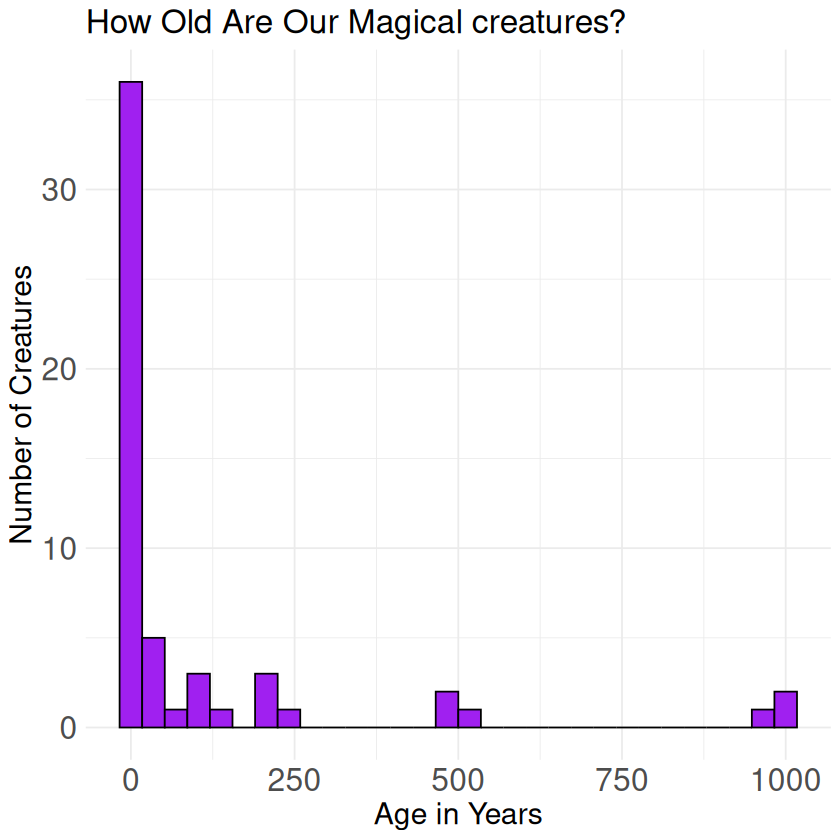
# Look at magic levels
magic_histogram <- ggplot(creature_data, aes(x = magic_power)) +
geom_histogram(fill = "gold", color = "black") +
labs(title = "Magic Level Distribution",
x = "Magic Level",
y = "Number of Creatures")+
theme_minimal() +
theme(text = element_text(size = 16),
plot.title = element_text(size = 20),
axis.title = element_text(size = 18),
axis.text = element_text(size = 19))
print(magic_histogram)
Challenge 1#
my_histogram <- ggplot(creature_data, aes(x = creature_age)) +
geom_histogram(fill = "lightblue",color = "white") +
labs(title = "Age Distribution",
x = "Age in Years",
y = "Number of Creatures")+
theme_minimal() +
theme(text = element_text(size = 16),
plot.title = element_text(size = 20),
axis.title = element_text(size = 18),
axis.text = element_text(size = 19))
my_histogram
Spell 6: Scatter Plot Magic#
This spell teaches creating scatter plots to explore relationships with 1 practice challenge.
Main Examples:#
# Show age vs magic data
print("👀 Let's see if age and magic are related:")
print("Age vs Magic Level for each creature:")
print(select(creature_data, creature_name, creature_age, magic_power))
# Create first scatter plot
age_vs_magic <- ggplot(creature_data, aes(x = creature_age, y = magic_power)) +
geom_point(size = 4, color = "orange") +
labs(title = "Do Older Creatures Have More Magic?",
x = "Age in Years",
y = "Magic Level")+
theme_minimal() +
theme(text = element_text(size = 16),
plot.title = element_text(size = 20),
axis.title = element_text(size = 18),
axis.text = element_text(size = 19))
print(age_vs_magic)
[1] "👀 Let's see if age and magic are related:"
[1] "Age vs Magic Level for each creature:"
creature_name creature_age magic_power
1 alita 100 10
2 stark 2 7
3 queenie 12 9
4 alita 7 10
5 penguino 9 10
6 john fairy 990 10
7 clash royal golem 200 10
8 pepy 1 1
9 nixie 8 7
10 rock 500 9
11 peaches 9 10
12 guy mann 45 1
13 magic_owl 100 9
14 mushu 2 7
15 gigachad 69 10
16 billy 131 10
17 iron golem 950 10
18 phantom 15 8
19 cerebrum 1000 10
20 draco 3 10
21 sigma 1 1
22 ice wolf 12 8
23 aquila phoenicus 512 10
24 john dragon 1 8
25 sweet_dumb_guy 15 4
26 soleil 500 10
27 firenz 200 10
28 anonymus 0 1
29 john unicorn 1 1
30 inferno 35 9
31 yao - atron 3000 25 6
32 kent.jr 6 7
33 creature 2 10
34 yao - atron 3000 b 25 6
35 butter toast 7 10
36 tiny 1 1
37 chester "cheesy" chiller 9 9
38 idk_bro 100 10
39 jrking 12 10
40 john griffin 1 6
41 hipie 1 2
42 gobby 3 4
43 marshmellow 200 9
44 sear 6 5
45 john goblin 1 2
46 lucy 0 1
47 the faliuer 22 10
48 mr jr 8 9
49 siren 250 10
50 john phoenix 1 1
51 1 1 1
52 john owl 1 1
53 john seahorse 1 2
54 john golem 1 8
55 mika 4 1 1
56 john werewolf 1 4

Challenge Solution:#
Challenge: Create scatter plot with creature_age on x-axis, magic_power on y-axis, colored by creature_type
colorful_scatter <- ggplot(creature_data, aes(x = creature_age, y = magic_power, color = creature_type)) +
geom_point(size = 5) +
labs(title = "Age vs Magic by Creature Type",
x = "Age in Years",
y = "Magic Level",
color = "Creature Type")+
theme_minimal() +
theme(text = element_text(size = 16),
plot.title = element_text(size = 20),
axis.title = element_text(size = 18),
axis.text = element_text(size = 19))
print(colorful_scatter)
Spell 7: Bar Chart Magic#
This spell teaches creating bar charts for comparisons with 1 practice challenge.
Main Examples:#
print("🏆 Ready for the creature competition!")
# Show creature type counts
print("🎯 Let's count our creature types:")
print(table(creature_data$creature_type))
[1] "🏆 Ready for the creature competition!"
[1] "🎯 Let's count our creature types:"
dragon elves fairy goblin golem griffin mermaid owl
6 4 4 5 8 1 1 3
phoenix seahorse unicorn werewolf
10 4 4 6
# Count how many of each creature type
creature_counts <- creature_data %>%
group_by(creature_type) %>%
summarize(total = n())
print("📊 Creature type counts:")
print(creature_counts)
[1] "📊 Creature type counts:"
# A tibble: 12 × 2
creature_type total
<chr> <int>
1 dragon 6
2 elves 4
3 fairy 4
4 goblin 5
5 golem 8
6 griffin 1
7 mermaid 1
8 owl 3
9 phoenix 10
10 seahorse 4
11 unicorn 4
12 werewolf 6
# Make the bar chart
creature_bar_chart <- ggplot(creature_counts, aes(x = creature_type, y = total)) +
geom_col(fill = "orange", color = "black") +
labs(title = "How Many of Each Creature Type?",
x = "Creature Type",
y = "Number of Creatures")+
theme_minimal() +
theme(text = element_text(size = 16),
plot.title = element_text(size = 20),
axis.title = element_text(size = 18),
axis.text = element_text(size = 19),
axis.text.x = element_text(angle = 60, hjust = 1))
print(creature_bar_chart)
# Compare average magic levels
magic_by_type <- creature_data %>%
group_by(creature_type) %>%
summarize(average_magic = mean(magic_power))
print("⚡ Average magic by creature type:")
print(magic_by_type)
magic_bar_chart <- ggplot(magic_by_type, aes(x = creature_type, y = average_magic)) +
geom_col(fill = "purple", color = "black") +
labs(title = "Which Creature Type is Most Magical?",
x = "Creature Type",
y = "Average Magic Level")+
theme_minimal() +
theme(text = element_text(size = 16),
plot.title = element_text(size = 20),
axis.title = element_text(size = 18),
axis.text = element_text(size = 19),
axis.text.x = element_text(angle = 60, hjust = 1))
print(magic_bar_chart)
Challenge Solution:#
Challenge: Create bar chart showing average age for each creature type
age_totals <- creature_data %>%
group_by(creature_type) %>%
summarize(average_age = mean(creature_age))
age_bar_chart <- ggplot(age_totals, aes(x = creature_type, y = average_age)) +
geom_col(fill = "skyblue", color = "black") +
labs(title = "Average Age by Creature Type",
x = "Creature Type",
y = "Average Age (Years)")+
theme_minimal() +
theme(text = element_text(size = 16),
plot.title = element_text(size = 20),
axis.title = element_text(size = 18),
axis.text = element_text(size = 19),
axis.text.x = element_text(angle = 60, hjust = 1))
print(age_bar_chart)
Spell 8: Team Data Detective Project (Overview)#
This is the overview spell that introduces the team project concept.
Complete Solution Code:#
Spell 8A: Team Project - Creatures Mystery#
This project uses creatures.csv and has 4 questions plus 2 challenges.
Setup:#
# Load tools and data
library(dplyr)
library(ggplot2)
creature_data <- read.csv("../datasets/creatures.csv")
#print("🔍 Evidence loaded from creatures.csv")
#head(creature_data)
Question 1: Which creature type has the highest average magic power?#
# Average magic by creature type
avg_magic_by_type <- creature_data %>%
group_by(creature_type) %>%
summarize(average_magic = mean(magic_power)) %>%
arrange(desc(average_magic))
print(avg_magic_by_type)
avg_magic_plot <- ggplot(avg_magic_by_type, aes(x = creature_type, y = average_magic)) +
geom_col(fill = "purple", color = "black") +
labs(title = "Average Magic by Creature Type",
x = "Creature Type", y = "Average Magic Power")+
theme_minimal() +
theme(text = element_text(size = 16),
plot.title = element_text(size = 20),
axis.title = element_text(size = 18),
axis.text = element_text(size = 19),
axis.text.x = element_text(angle = 60, hjust = 1))
print(avg_magic_plot)
Question 2: Do winged creatures tend to be more powerful?#
# Compare winged vs non-winged
winged_compare <- creature_data %>%
group_by(has_wings) %>%
summarize(average_magic = mean(magic_power), count = n())
print(winged_compare)
winged_plot <- ggplot(winged_compare, aes(x = has_wings, y = average_magic, fill = has_wings)) +
geom_col(color = "black") +
labs(title = "Do Winged Creatures Have More Magic?",
x = "Has Wings?", y = "Average Magic Power", fill = "Has Wings")+
theme_minimal() +
theme(text = element_text(size = 16),
plot.title = element_text(size = 20),
axis.title = element_text(size = 18),
axis.text = element_text(size = 19))
print(winged_plot)
Question 3: Are older creatures more magical?#
# Relationship between age and magic
age_magic_plot <- ggplot(creature_data, aes(x = creature_age, y = magic_power, color = creature_type)) +
geom_point(size = 4) +
labs(title = "Are Older Creatures More Magical?",
x = "Age in Years", y = "Magic Power", color = "Creature Type")+
theme_minimal() +
theme(text = element_text(size = 16),
plot.title = element_text(size = 20),
axis.title = element_text(size = 18),
axis.text = element_text(size = 19))
print(age_magic_plot)
Question 4: What does the distribution of magic power look like?#
# Magic power distribution histogram
magic_hist <- ggplot(creature_data, aes(x = magic_power)) +
geom_histogram(fill = "gold", color = "black") +
labs(title = "Magic Power Distribution",
x = "Magic Power", y = "Number of Creatures")+
theme_minimal() +
theme(text = element_text(size = 16),
plot.title = element_text(size = 20),
axis.title = element_text(size = 18),
axis.text = element_text(size = 19))
print(magic_hist)
Challenge Solutions:#
Challenge 1: Which element has the highest average magic power?
element_magic <- creature_data %>%
group_by(element) %>%
summarize(average_magic = mean(magic_power), count = n()) %>%
arrange(desc(average_magic))
print("Average magic power by element:")
print(element_magic)
[1] "Average magic power by element:"
# A tibble: 4 × 3
element average_magic count
<chr> <dbl> <int>
1 fire 7.35 20
2 water 6.92 12
3 air 6.1 10
4 earth 6 14
Challenge 2: Which three creatures have the highest magic power?
top_creatures <- creature_data %>%
arrange(desc(magic_power)) %>%
select(creature_name, creature_type, magic_power) %>%
head(3)
print("Top 3 most magical creatures:")
print(top_creatures)
[1] "Top 3 most magical creatures:"
creature_name creature_type magic_power
1 alita fairy 10
2 alita fairy 10
3 penguino seahorse 10
Spell 8B: Team Project - Magical Pets Mystery#
This project uses magical_pets.csv and has 5 questions.
Setup:#
# Load tools and data
library(dplyr)
library(ggplot2)
pets_data <- read.csv("../datasets/magical_pets.csv")
print("🔍 Evidence loaded from magical_pets.csv")
head(pets_data)
[1] "🔍 Evidence loaded from magical_pets.csv"
| pet_name | pet_type | age_years | magic_level | favorite_treat | |
|---|---|---|---|---|---|
| <chr> | <chr> | <int> | <int> | <chr> | |
| 1 | Sparkles | Unicorn | 150 | 85 | Rainbow cookies |
| 2 | Thunder | Dragon | 300 | 95 | Gold coins |
| 3 | Whiskers | Cat | 3 | 20 | Rainbow cookies |
| 4 | Flame | Phoenix | 75 | 90 | Spicy peppers |
| 5 | Bubbles | Fish | 1 | 15 | Magic algae |
| 6 | Shadow | Wolf | 8 | 60 | Moon berries |
Question 1: Which favorite treat is most popular among pets?#
# Count by favorite treat
treat_counts <- pets_data %>%
group_by(favorite_treat) %>%
summarize(count = n()) %>%
arrange(desc(count))
print(treat_counts)
# Bar plot to show how many pets like each treat
treat_bar <- ggplot(treat_counts, aes(x = favorite_treat, y = count)) +
geom_col(fill = "orange", color = "black") +
labs(title = "Most Popular Favorite Treats",
x = "Favorite Treat", y = "Number of Pets")+
theme_minimal() +
theme(text = element_text(size = 16),
plot.title = element_text(size = 20),
axis.title = element_text(size = 18),
axis.text = element_text(size = 19),
axis.text.x = element_text(angle = 60, hjust = 1))
print(treat_bar)
Question 2: Do pets who like that treat also tend to have higher magic levels?#
# Average magic by favorite treat
treat_magic <- pets_data %>%
group_by(favorite_treat) %>%
summarize(average_magic = mean(magic_level)) %>%
arrange(desc(average_magic))
print(treat_magic)
treat_magic_bar <- ggplot(treat_magic, aes(x = favorite_treat, y = average_magic)) +
geom_col(fill = "purple", color = "black") +
labs(title = "Average Magic by Favorite Treat",
x = "Favorite Treat", y = "Average Magic Level")+
theme_minimal() +
theme(text = element_text(size = 16),
plot.title = element_text(size = 20),
axis.title = element_text(size = 18),
axis.text = element_text(size = 19),
axis.text.x = element_text(angle = 60, hjust = 1))
print(treat_magic_bar)
Question 3: Which pet type has the highest average magic level?#
# Average magic by pet type
type_magic <- pets_data %>%
group_by(pet_type) %>%
summarize(average_magic = mean(magic_level), count = n()) %>%
arrange(desc(average_magic))
print(type_magic)
type_magic_bar <- ggplot(type_magic, aes(x = pet_type, y = average_magic)) +
geom_col(fill = "skyblue", color = "black") +
labs(title = "Which Pet Type is the Most Magical?",
x = "Pet Type", y = "Average Magic Level")+
theme_minimal() +
theme(text = element_text(size = 16),
plot.title = element_text(size = 20),
axis.title = element_text(size = 18),
axis.text = element_text(size = 19),
axis.text.x = element_text(angle = 60, hjust = 1))
print(type_magic_bar)
Question 4: Are older pets more magical?#
# Scatter plot of age vs magic level
pets_scatter <- ggplot(pets_data, aes(x = age_years, y = magic_level, color = pet_type)) +
geom_point(size = 4) +
labs(title = "Are Older Pets More Magical?",
x = "Age (years)", y = "Magic Level", color = "Pet Type")+
theme_minimal() +
theme(text = element_text(size = 16),
plot.title = element_text(size = 20),
axis.title = element_text(size = 18),
axis.text = element_text(size = 19))
print(pets_scatter)
Question 5: What does the distribution of magic levels look like?#
# Histogram of magic level distribution
pets_magic_hist <- ggplot(pets_data, aes(x = magic_level)) +
geom_histogram(fill = "orange", color = "black") +
labs(title = "Distribution of Pet Magic Levels",
x = "Magic Level", y = "Number of Pets")+
theme_minimal() +
theme(text = element_text(size = 16),
plot.title = element_text(size = 20),
axis.title = element_text(size = 18),
axis.text = element_text(size = 19))
print(pets_magic_hist)
Spell 8C: Team Project - Creature Sightings Mystery#
This project uses creature_sightings.csv and has 4 questions including the new ones added.
Setup:#
# Load tools and data
library(dplyr)
library(ggplot2)
creatures_data <- read.csv("../datasets/creature_sightings.csv")
print("🔍 Evidence loaded from creature_sightings.csv")
head(creatures_data)
[1] "🔍 Evidence loaded from creature_sightings.csv"
| creature_type | location | time_of_day | weather | rarity_score | photographer_level | |
|---|---|---|---|---|---|---|
| <chr> | <chr> | <chr> | <chr> | <int> | <int> | |
| 1 | Dragon | Thunder_Mountain | Evening | Stormy | 9 | 4 |
| 2 | Unicorn | Enchanted_Forest | Dawn | Sunny | 8 | 3 |
| 3 | Fairy | Crystal_Cave | Night | Cloudy | 6 | 2 |
| 4 | Troll | Mystic_Lake | Morning | Rainy | 4 | 1 |
| 5 | Centaur | Enchanted_Forest | Afternoon | Sunny | 7 | 3 |
| 6 | Dragon | Crystal_Cave | Night | Stormy | 10 | 5 |
Question 1: Which location has the most creature sightings?#
# Count by location
by_location <- creatures_data %>%
group_by(location) %>%
summarize(count = n()) %>%
arrange(desc(count))
print(by_location)
location_plot <- ggplot(by_location, aes(x = location, y = count)) +
geom_col(fill = "steelblue", color = "black") +
labs(title = "Sightings by Location", x = "Location", y = "Sightings")+
theme_minimal() +
theme(text = element_text(size = 16),
plot.title = element_text(size = 20),
axis.title = element_text(size = 18),
axis.text = element_text(size = 19),
axis.text.x = element_text(angle = 60, hjust = 1))
print(location_plot)
Question 2: What’s the rarest creature type (lowest average rarity_score)?#
# Rarest creature by average rarity score
rare_by_type <- creatures_data %>%
group_by(creature_type) %>%
summarize(average_rarity = mean(rarity_score), count = n()) %>%
arrange(average_rarity)
print(rare_by_type)
rare_plot <- ggplot(rare_by_type, aes(x = creature_type, y = average_rarity)) +
geom_col(fill = "plum", color = "black") +
labs(title = "Average Rarity by Creature Type", x = "Creature Type", y = "Average Rarity")+
theme_minimal() +
theme(text = element_text(size = 16),
plot.title = element_text(size = 20),
axis.title = element_text(size = 18),
axis.text = element_text(size = 19),
axis.text.x = element_text(angle = 60, hjust = 1))
print(rare_plot)
Question 3: What time of the day would you most likely to encounter a creature?#
# Count by time of day
by_time <- creatures_data %>%
group_by(time_of_day) %>%
summarize(count = n()) %>%
arrange(desc(count))
print(by_time)
time_plot <- ggplot(by_time, aes(x = time_of_day, y = count)) +
geom_col(fill = "orange", color = "black") +
labs(title = "Creature Sightings by Time of Day", x = "Time of Day", y = "Number of Sightings")+
theme_minimal() +
theme(text = element_text(size = 16),
plot.title = element_text(size = 20),
axis.title = element_text(size = 18),
axis.text = element_text(size = 19),
axis.text.x = element_text(angle = 60, hjust = 1))
print(time_plot)
Question 4: Is there a relationship between rarity score and photographer level? (scatter plot)#
# Create scatter plot
scatter_plot <- ggplot(creatures_data, aes(x = photographer_level, y = rarity_score)) +
geom_point(size = 3, color = "darkgreen", alpha = 0.7) +
labs(title = "Rarity Score vs Photographer Level",
x = "Photographer Level",
y = "Rarity Score") +
theme_minimal() +
theme(text = element_text(size = 16),
plot.title = element_text(size = 20),
axis.title = element_text(size = 18),
axis.text = element_text(size = 19))
print(scatter_plot)
Spell 8D: Team Project - Magic School Mystery#
This project uses magic_school_grades.csv and has 3 questions plus a challenge, with the updated structure including 3x1 grid histograms.
Setup:#
# Load tools and data
library(dplyr)
library(ggplot2)
library(gridExtra)
school_data <- read.csv("../datasets/magic_school_grades.csv")
print("🔍 Evidence loaded from magic_school_grades.csv")
head(school_data)
Attaching package: ‘gridExtra’
The following object is masked from ‘package:dplyr’:
combine
[1] "🔍 Evidence loaded from magic_school_grades.csv"
| student_name | house | grade | magic_score | potion_score | flying_score | has_pet | |
|---|---|---|---|---|---|---|---|
| <chr> | <chr> | <int> | <int> | <int> | <int> | <lgl> | |
| 1 | Luna | Fire | 2 | 80 | 90 | 75 | TRUE |
| 2 | Max | Water | 4 | 92 | 85 | 88 | FALSE |
| 3 | Zara | Earth | 2 | 73 | 95 | 70 | TRUE |
| 4 | Finn | Air | 4 | 90 | 80 | 92 | TRUE |
| 5 | Nova | Fire | 4 | 88 | 85 | 95 | FALSE |
| 6 | Sage | Water | 2 | 77 | 90 | 78 | TRUE |
Question 1: What’s the distribution of scores for each subject? (3 histograms in 3x1 grid)#
# Create 3 histograms stacked on top of each other
# Magic score
magic_hist <- ggplot(school_data, aes(x = magic_score)) +
geom_histogram(fill = "#d578f2fc", color = "black", alpha = 0.7) +
labs(title = "Magic Score Distribution", x = "Magic Score", y = "Count")+
xlim(0, 100) +
ylim(0, 18) +
theme_minimal() +
theme(text = element_text(size = 14),
plot.title = element_text(size = 18),
axis.title = element_text(size = 16),
axis.text = element_text(size = 17))
# Potion score
potion_hist <- ggplot(school_data, aes(x = potion_score)) +
geom_histogram(fill = "#87d31d", color = "black", alpha = 0.7) +
labs(title = "Potion Score Distribution", x = "Potion Score", y = "Count")+
xlim(0, 100) +
ylim(0, 18) +
theme_minimal() +
theme(text = element_text(size = 14),
plot.title = element_text(size = 18),
axis.title = element_text(size = 16),
axis.text = element_text(size = 17))
# Flying score
flying_hist <- ggplot(school_data, aes(x = flying_score)) +
geom_histogram(fill = "#58c4ef", color = "black", alpha = 0.7) +
labs(title = "Flying Score Distribution", x = "Flying Score", y = "Count")+
xlim(0, 100) +
ylim(0, 18) +
theme_minimal() +
theme(text = element_text(size = 14),
plot.title = element_text(size = 18),
axis.title = element_text(size = 16),
axis.text = element_text(size = 17))
# Arrange the three histograms in a 3x1 grid (3 rows, 1 column)
grid_plot <- grid.arrange(magic_hist, potion_hist, flying_hist, nrow = 3, ncol = 1)
print(grid_plot)
`stat_bin()` using `bins = 30`. Pick better value with `binwidth`.
Warning message:
“Removed 2 rows containing missing values or values outside the scale range
(`geom_bar()`).”
`stat_bin()` using `bins = 30`. Pick better value with `binwidth`.
Warning message:
“Removed 3 rows containing missing values or values outside the scale range
(`geom_bar()`).”
`stat_bin()` using `bins = 30`. Pick better value with `binwidth`.
Warning message:
“Removed 2 rows containing missing values or values outside the scale range
(`geom_bar()`).”
TableGrob (3 x 1) "arrange": 3 grobs
z cells name grob
1 1 (1-1,1-1) arrange gtable[layout]
2 2 (2-2,1-1) arrange gtable[layout]
3 3 (3-3,1-1) arrange gtable[layout]
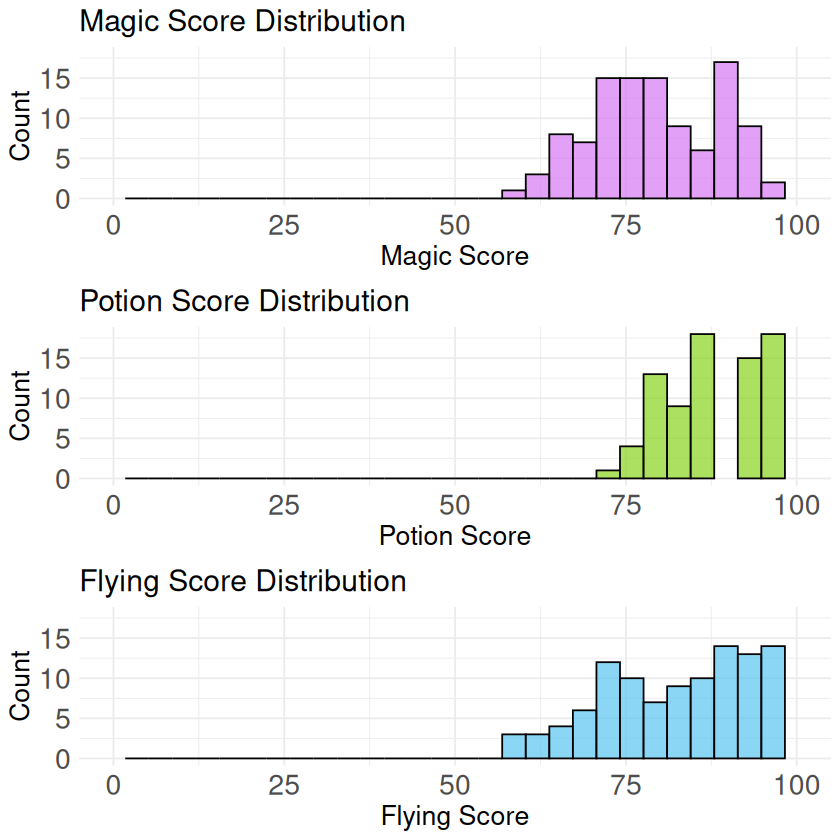
Question 2: Do people who have a pet have better magic scores?#
# Compare magic scores between pet owners and non-pet owners
pet_comparison <- school_data %>%
group_by(has_pet) %>%
summarize(avg_magic = mean(magic_score), count = n())
print(pet_comparison)
# Method 1: Two histograms stacked on top of each other using 2x1 grid
# Filter data for pet owners
pet_owners <- school_data %>% filter(has_pet == TRUE)
non_pet_owners <- school_data %>% filter(has_pet == FALSE)
# Histogram for pet owners
pet_hist <- ggplot(pet_owners, aes(x = magic_score)) +
geom_histogram(fill = "#87ceeb", color = "black", alpha = 0.7) +
labs(title = "Magic Scores: Pet Owners", x = "Magic Score", y = "Count") +
xlim(10, 100) +
ylim(0, 18) +
theme_minimal() +
theme(text = element_text(size = 14),
plot.title = element_text(size = 18),
axis.title = element_text(size = 16),
axis.text = element_text(size = 17))
# Histogram for non-pet owners
no_pet_hist <- ggplot(non_pet_owners, aes(x = magic_score)) +
geom_histogram(fill = "#ffb6c1", color = "black", alpha = 0.7) +
labs(title = "Magic Scores: Non-Pet Owners", x = "Magic Score", y = "Count") +
xlim(0, 100) +
ylim(0, 18) +
theme_minimal() +
theme(text = element_text(size = 14),
plot.title = element_text(size = 18),
axis.title = element_text(size = 16),
axis.text = element_text(size = 17))
# Arrange histograms in 2x1 grid
hist_grid <- grid.arrange(pet_hist, no_pet_hist, nrow = 2, ncol = 1)
print(hist_grid)
# A tibble: 2 × 3
has_pet avg_magic count
<lgl> <dbl> <int>
1 FALSE 85.6 50
2 TRUE 73.8 57
`stat_bin()` using `bins = 30`. Pick better value with `binwidth`.
Warning message:
“Removed 2 rows containing missing values or values outside the scale range
(`geom_bar()`).”
`stat_bin()` using `bins = 30`. Pick better value with `binwidth`.
Warning message:
“Removed 2 rows containing missing values or values outside the scale range
(`geom_bar()`).”
TableGrob (2 x 1) "arrange": 2 grobs
z cells name grob
1 1 (1-1,1-1) arrange gtable[layout]
2 2 (2-2,1-1) arrange gtable[layout]
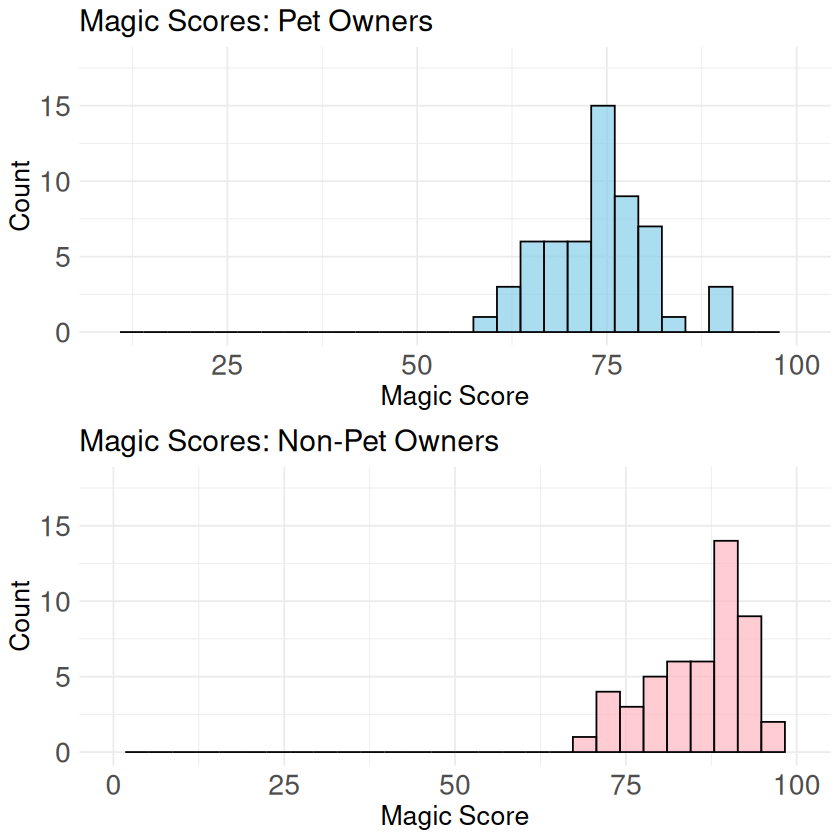
# Method 2: Bar plot showing average magic scores
avg_plot <- ggplot(pet_comparison, aes(x = has_pet, y = avg_magic, fill = has_pet)) +
geom_col(color = "black", alpha = 0.8) +
labs(title = "Average Magic Scores: Pet Owners vs Non-Pet Owners",
x = "Has Pet", y = "Average Magic Score", fill = "Has Pet") +
theme_minimal() +
theme(text = element_text(size = 14),
plot.title = element_text(size = 18),
axis.title = element_text(size = 16),
axis.text = element_text(size = 17))
print(avg_plot)
Question 3: Is there a relationship between potion score and flying score? (scatter plot)#
# Create scatter plot to see relationship
pf_scatter <- ggplot(school_data, aes(x = potion_score, y = flying_score, color = house)) +
geom_point(size = 4, alpha = 0.7) +
labs(title = "Potion vs Flying Scores",
x = "Potion Score", y = "Flying Score", color = "House") +
xlim(70, 100) +
ylim(55, 100) +
theme_minimal() +
theme(text = element_text(size = 16),
plot.title = element_text(size = 20),
axis.title = element_text(size = 18),
axis.text = element_text(size = 19))
print(pf_scatter)
Challenge: Students from which house has the best score on average?#
# Calculate overall average score for each house
house_analysis <- school_data %>%
mutate(overall_score = (magic_score + potion_score + flying_score) / 3) %>%
group_by(house) %>%
summarize(avg_overall = mean(overall_score), count = n()) %>%
arrange(desc(avg_overall))
print("Average overall scores by house:")
print(house_analysis)
# Visualize the results
house_plot <- ggplot(house_analysis, aes(x = house, y = avg_overall, fill = house)) +
geom_col(color = "black") +
labs(title = "Average Overall Score by House",
x = "House", y = "Average Overall Score", fill = "House")+
theme_minimal() +
theme(text = element_text(size = 16),
plot.title = element_text(size = 20),
axis.title = element_text(size = 18),
axis.text = element_text(size = 19))
print(house_plot)
🎉 Congratulations!#
You’ve completed all Day 3 spells! Keep practicing these magical data skills! 🔮✨

